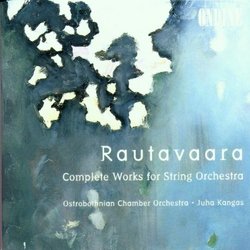It all started with his 3rd Symphony and "Cantus Arcticus."
Bob Zeidler | Charlton, MA United States | 10/24/2001
(5 out of 5 stars)
"It started innocently enough. Approximately a year and a half ago, I had barely - if that - a subliminal awareness of Einojuhani Rautavaara as a "contemporary" composer, one of a large number of present-day Finnish composers. (There is something weirdly wonderful about such a small country having such a large number of active - and recognized - composers, but that is a whole 'nother story.)
In the intervening 18 months, that initial hearing of Rautavaara's music (on a Naxos release which I review elsewhere at Amazon.com) led me to become pretty much a Rautavaara "compleatist." As I write this, there are very few holes in my library of his music, and I figure that those holes will be plugged rather quickly. He's had that kind of effect on me.
This double-CD album of Rautavaara's complete works for string orchestra is the latest release by Ondine, the Finnish label which has an exclusive contract for first recorded performances of his works. The compositional period covered almost matches Rautavaara's career, in that dates for the various works cover the period 1952 - 1993. The album provides, as a result, an excellent overview of how his style has changed throughout his career, from Stravinsky-like neoClassicism in the earlier works to his mature evocative "Angels" style of his later works.
The album begins - logically enough - with his Op. 1, Pelimannit ("The Fiddlers" [1952]), a whacky riot of fun with its occasional off-tune fiddling. The next two works (Divertimento [1953] and Suite for Strings [1952]) clearly suggest the neoClassicism of Stravinsky (an early idol of Rautavaara's), but it is also possible to read into these works the sound worlds of both Britten and Respighi in the ways that they evoked earlier styles. Taken together, these three youthful works capture Rautavaara's early style, which goes down very easily in its accessibility.
The next set of three works - homages to the three most famous Hungarian composers (Liszt, Bartók and Kodály) - may not have been intentionally meant to suggest the Ugric ties between the languages of these two countries (Finland and Hungary). These three pieces do capture, however obliquely, various aspects of the three composers' styles, with the Hommage à Kodály Zoltán being the most "Hungarian-sounding." A somewhat more challenging triptych than the first three works, but not at all inaccessible.
The four Cantos opening the second CD show how, over time, Rautavaara developed a post-modernist "late period" style that synthesized many of his earlier styles (including serial, or twelve-tone, efforts). The two earlier Cantos begin to show his unique approach to serialism that was more fully realized in his echt-Bruckner 3rd Symphony; they put the lie to twelve-tone music being "unlistenable." The two later Cantos show Rautavaara's evocatively rhapsodic "Angels" style in full bloom, as do the following two pieces (Ballad for Harp and Strings, and A Finnish Myth).
The album comes full-circle with the final work, Ostrobothnian Polksa, more good cheer in the vein of the Op. 1 opening work. I think that opening work will hook you, and that the balance of this comprehensive album will be equally enjoyable. I may be a Rautavaara compleatist, but this album will be immensely appealing to all who hear it. And do check out that Naxos album I mention at the outset of these comments. That's a great one as well.
Bob Zeidler"


 Track Listings (14) - Disc #1
Track Listings (14) - Disc #1